heating Mercury Villager 2000 Owner's Manuals
[x] Cancel search | Manufacturer: MERCURY, Model Year: 2000, Model line: Villager, Model: Mercury Villager 2000Pages: 256, PDF Size: 2.21 MB
Page 16 of 256
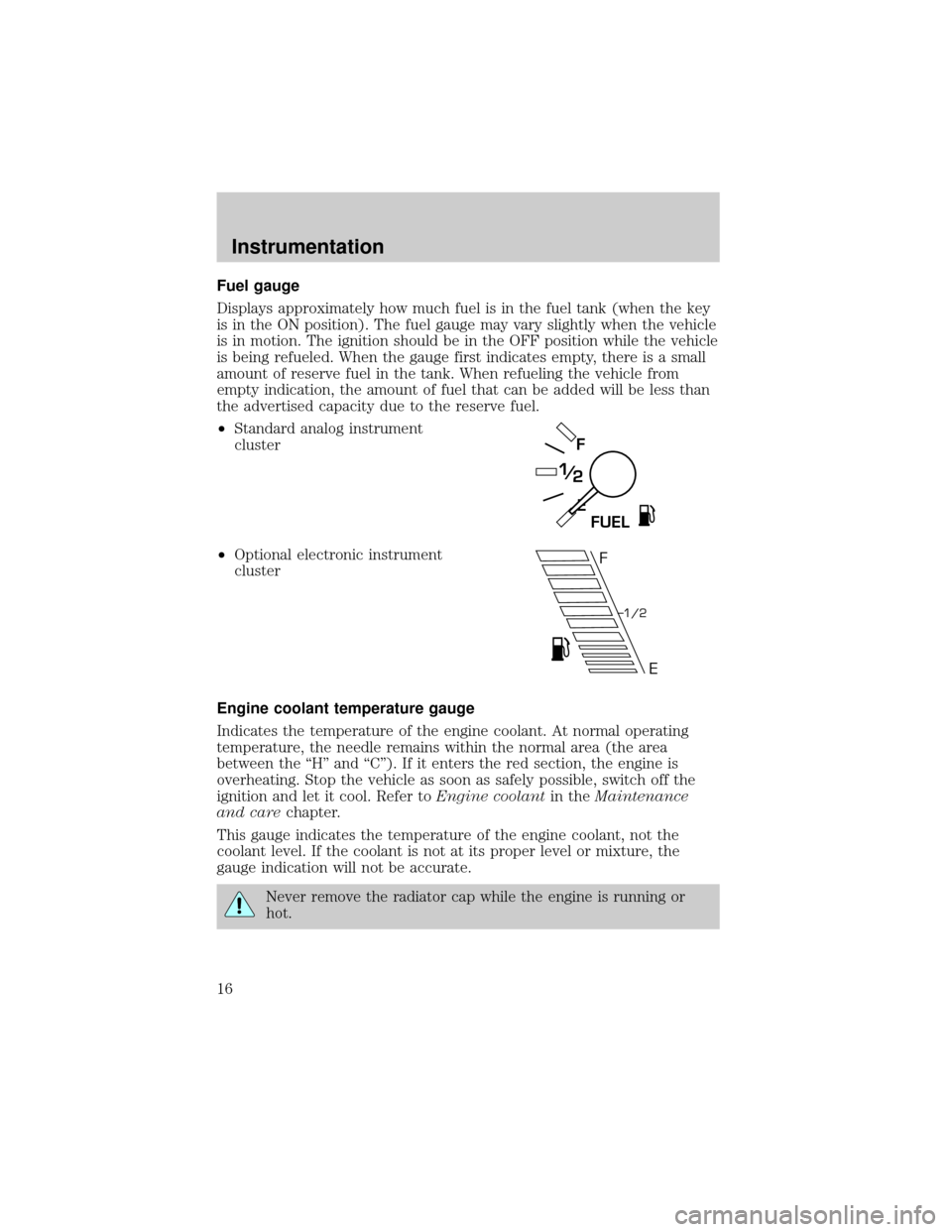
Fuel gauge
Displays approximately how much fuel is in the fuel tank (when the key
is in the ON position). The fuel gauge may vary slightly when the vehicle
is in motion. The ignition should be in the OFF position while the vehicle
is being refueled. When the gauge first indicates empty, there is a small
amount of reserve fuel in the tank. When refueling the vehicle from
empty indication, the amount of fuel that can be added will be less than
the advertised capacity due to the reserve fuel.
²Standard analog instrument
cluster
²Optional electronic instrument
cluster
Engine coolant temperature gauge
Indicates the temperature of the engine coolant. At normal operating
temperature, the needle remains within the normal area (the area
between the ªHº and ªCº). If it enters the red section, the engine is
overheating. Stop the vehicle as soon as safely possible, switch off the
ignition and let it cool. Refer toEngine coolantin theMaintenance
and carechapter.
This gauge indicates the temperature of the engine coolant, not the
coolant level. If the coolant is not at its proper level or mixture, the
gauge indication will not be accurate.
Never remove the radiator cap while the engine is running or
hot.
E
F
FUEL
F
E
1/2
Instrumentation
16
Page 22 of 256
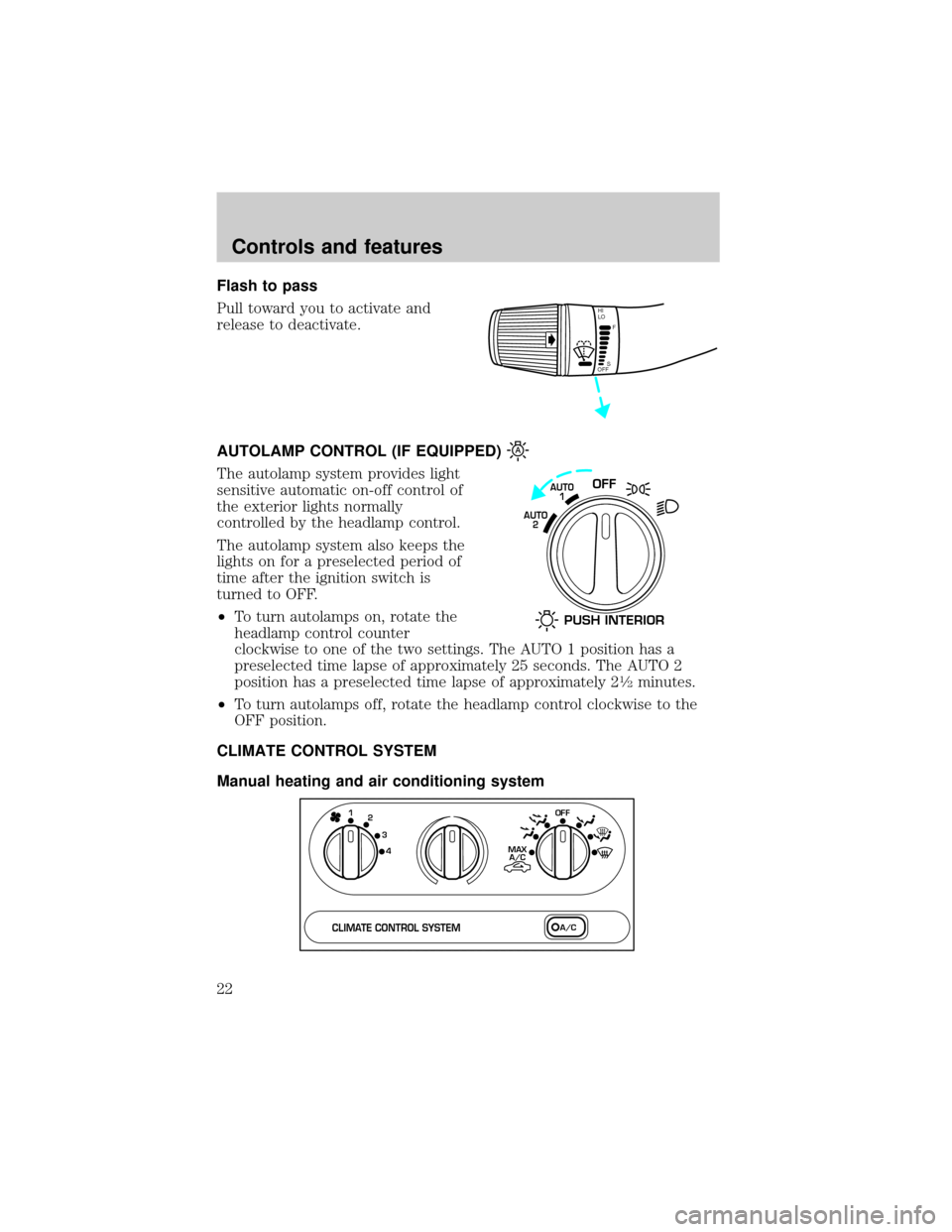
Flash to pass
Pull toward you to activate and
release to deactivate.
AUTOLAMP CONTROL (IF EQUIPPED)
The autolamp system provides light
sensitive automatic on-off control of
the exterior lights normally
controlled by the headlamp control.
The autolamp system also keeps the
lights on for a preselected period of
time after the ignition switch is
turned to OFF.
²To turn autolamps on, rotate the
headlamp control counter
clockwise to one of the two settings. The AUTO 1 position has a
preselected time lapse of approximately 25 seconds. The AUTO 2
position has a preselected time lapse of approximately 2
1¤2minutes.
²To turn autolamps off, rotate the headlamp control clockwise to the
OFF position.
CLIMATE CONTROL SYSTEM
Manual heating and air conditioning system
HI
LO
F
S
OFF
OFFAUTO
1
AUTO
2
PUSH INTERIOR
1
MAX
A/C
A/C OFF2
3
4
CLIMATE CONTROL SYSTEM
Controls and features
22
Page 24 of 256
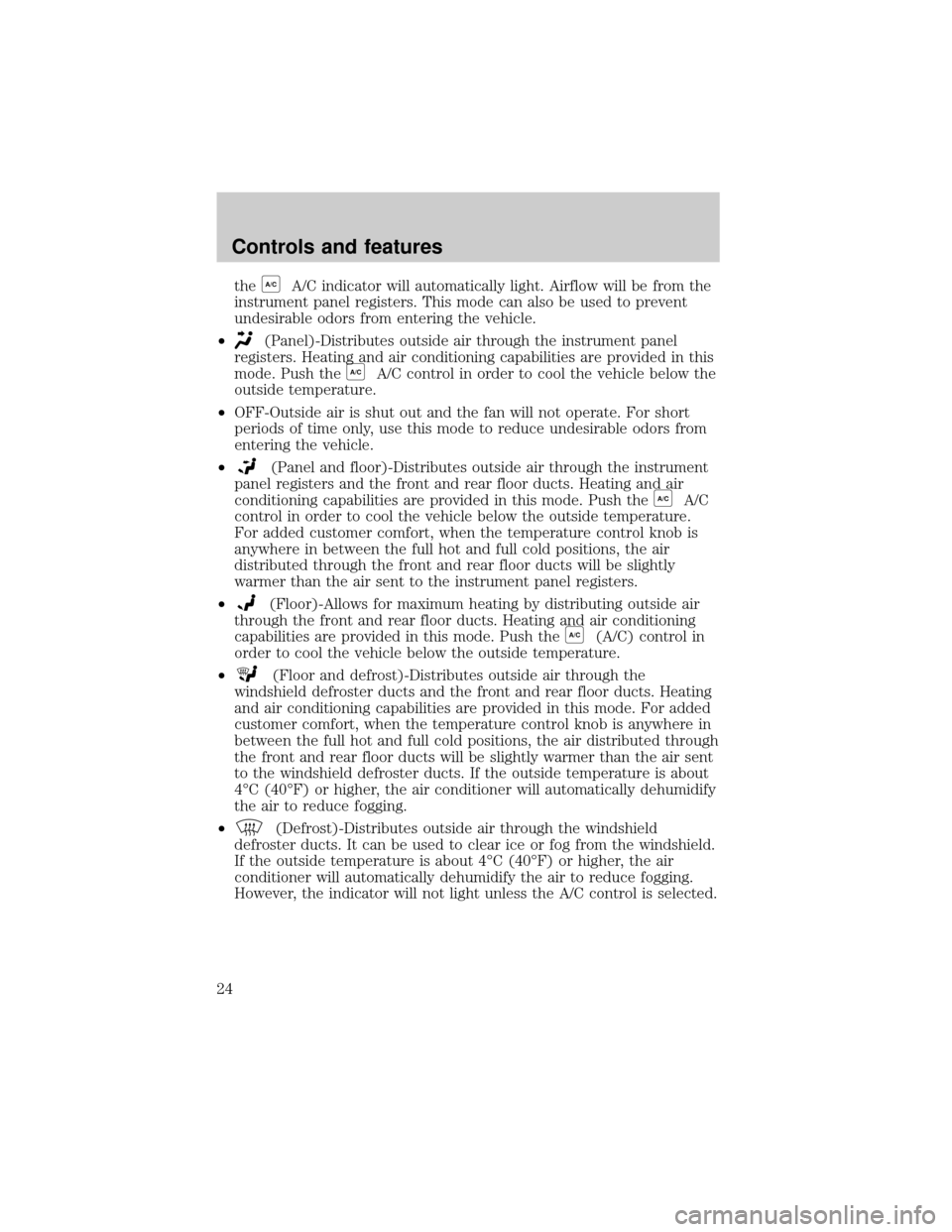
theA/CA/C indicator will automatically light. Airflow will be from the
instrument panel registers. This mode can also be used to prevent
undesirable odors from entering the vehicle.
²
(Panel)-Distributes outside air through the instrument panel
registers. Heating and air conditioning capabilities are provided in this
mode. Push the
A/CA/C control in order to cool the vehicle below the
outside temperature.
²OFF-Outside air is shut out and the fan will not operate. For short
periods of time only, use this mode to reduce undesirable odors from
entering the vehicle.
²
(Panel and floor)-Distributes outside air through the instrument
panel registers and the front and rear floor ducts. Heating and air
conditioning capabilities are provided in this mode. Push the
A/CA/C
control in order to cool the vehicle below the outside temperature.
For added customer comfort, when the temperature control knob is
anywhere in between the full hot and full cold positions, the air
distributed through the front and rear floor ducts will be slightly
warmer than the air sent to the instrument panel registers.
²
(Floor)-Allows for maximum heating by distributing outside air
through the front and rear floor ducts. Heating and air conditioning
capabilities are provided in this mode. Push the
A/C(A/C) control in
order to cool the vehicle below the outside temperature.
²
(Floor and defrost)-Distributes outside air through the
windshield defroster ducts and the front and rear floor ducts. Heating
and air conditioning capabilities are provided in this mode. For added
customer comfort, when the temperature control knob is anywhere in
between the full hot and full cold positions, the air distributed through
the front and rear floor ducts will be slightly warmer than the air sent
to the windshield defroster ducts. If the outside temperature is about
4ÉC (40ÉF) or higher, the air conditioner will automatically dehumidify
the air to reduce fogging.
²
(Defrost)-Distributes outside air through the windshield
defroster ducts. It can be used to clear ice or fog from the windshield.
If the outside temperature is about 4ÉC (40ÉF) or higher, the air
conditioner will automatically dehumidify the air to reduce fogging.
However, the indicator will not light unless the A/C control is selected.
Controls and features
24
Page 25 of 256
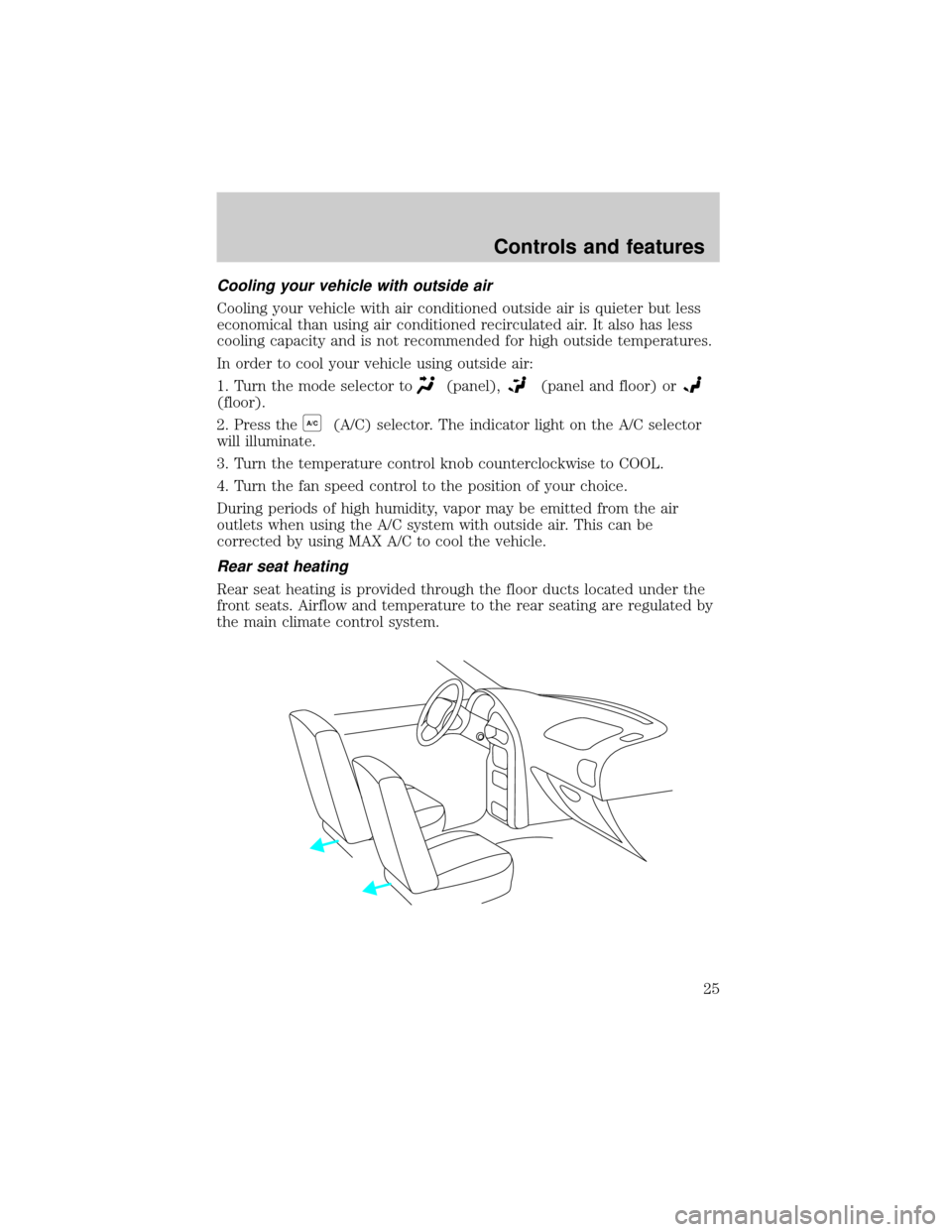
Cooling your vehicle with outside air
Cooling your vehicle with air conditioned outside air is quieter but less
economical than using air conditioned recirculated air. It also has less
cooling capacity and is not recommended for high outside temperatures.
In order to cool your vehicle using outside air:
1. Turn the mode selector to
(panel),(panel and floor) or
(floor).
2. Press the
A/C(A/C) selector. The indicator light on the A/C selector
will illuminate.
3. Turn the temperature control knob counterclockwise to COOL.
4. Turn the fan speed control to the position of your choice.
During periods of high humidity, vapor may be emitted from the air
outlets when using the A/C system with outside air. This can be
corrected by using MAX A/C to cool the vehicle.
Rear seat heating
Rear seat heating is provided through the floor ducts located under the
front seats. Airflow and temperature to the rear seating are regulated by
the main climate control system.
Controls and features
25
Page 26 of 256
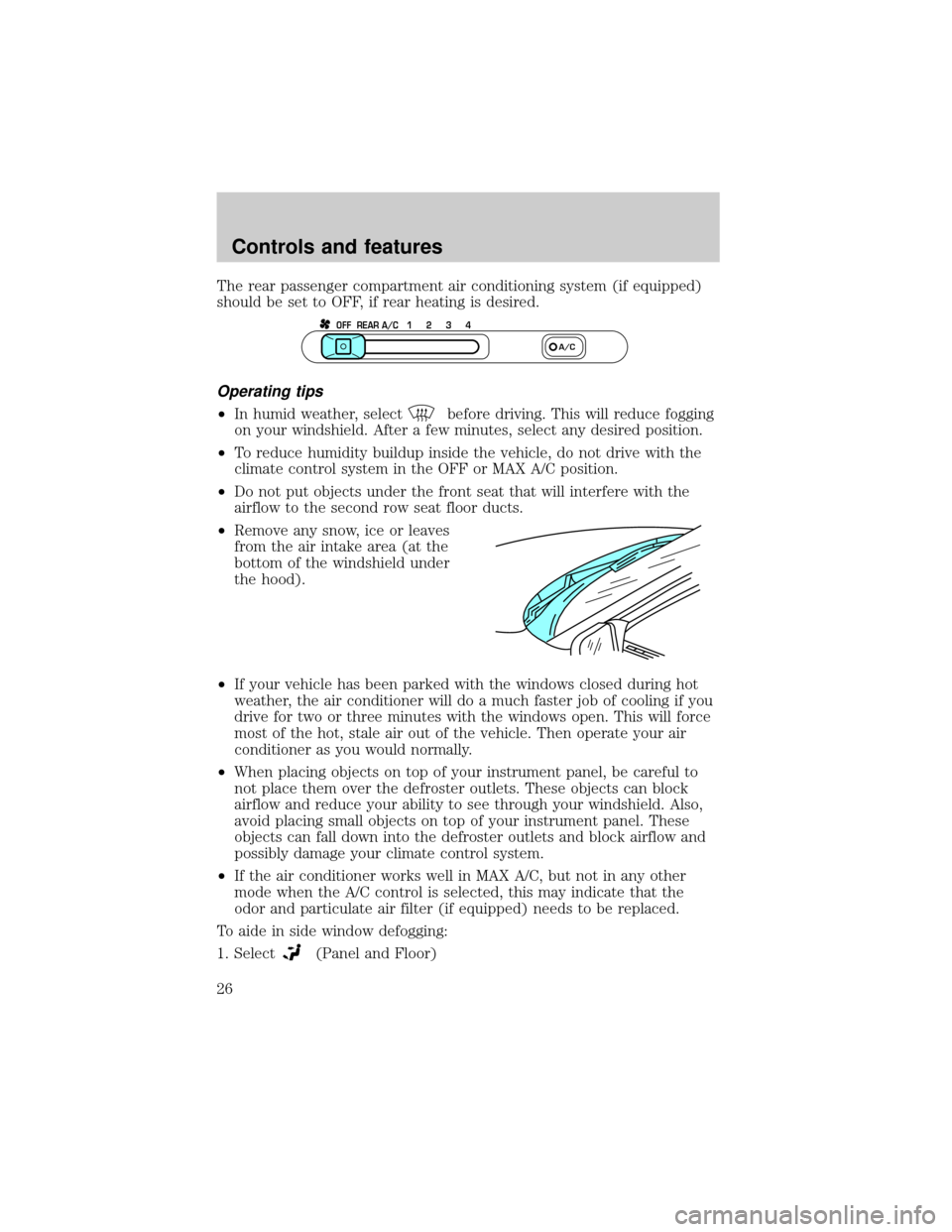
The rear passenger compartment air conditioning system (if equipped)
should be set to OFF, if rear heating is desired.
Operating tips
²In humid weather, selectbefore driving. This will reduce fogging
on your windshield. After a few minutes, select any desired position.
²To reduce humidity buildup inside the vehicle, do not drive with the
climate control system in the OFF or MAX A/C position.
²Do not put objects under the front seat that will interfere with the
airflow to the second row seat floor ducts.
²Remove any snow, ice or leaves
from the air intake area (at the
bottom of the windshield under
the hood).
²If your vehicle has been parked with the windows closed during hot
weather, the air conditioner will do a much faster job of cooling if you
drive for two or three minutes with the windows open. This will force
most of the hot, stale air out of the vehicle. Then operate your air
conditioner as you would normally.
²When placing objects on top of your instrument panel, be careful to
not place them over the defroster outlets. These objects can block
airflow and reduce your ability to see through your windshield. Also,
avoid placing small objects on top of your instrument panel. These
objects can fall down into the defroster outlets and block airflow and
possibly damage your climate control system.
²If the air conditioner works well in MAX A/C, but not in any other
mode when the A/C control is selected, this may indicate that the
odor and particulate air filter (if equipped) needs to be replaced.
To aide in side window defogging:
1. Select
(Panel and Floor)
OFF REAR A/C 1 2 3 4
A/C
Controls and features
26
Page 29 of 256
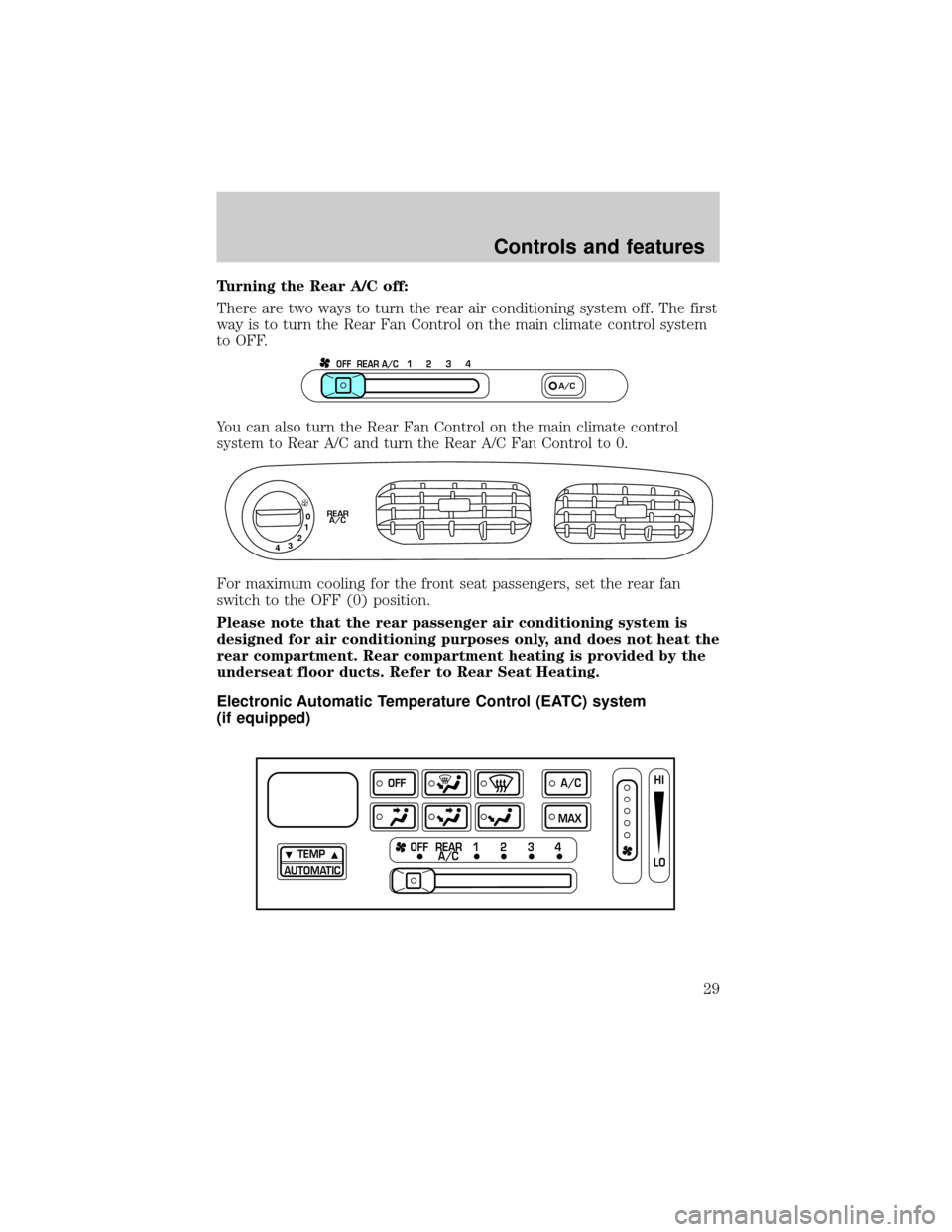
Turning the Rear A/C off:
There are two ways to turn the rear air conditioning system off. The first
way is to turn the Rear Fan Control on the main climate control system
to OFF.
You can also turn the Rear Fan Control on the main climate control
system to Rear A/C and turn the Rear A/C Fan Control to 0.
For maximum cooling for the front seat passengers, set the rear fan
switch to the OFF (0) position.
Please note that the rear passenger air conditioning system is
designed for air conditioning purposes only, and does not heat the
rear compartment. Rear compartment heating is provided by the
underseat floor ducts. Refer to Rear Seat Heating.
Electronic Automatic Temperature Control (EATC) system
(if equipped)
OFF REAR A/C 1 2 3 4
A/C
0
1
2
3
4REAR
A/C
TEMP
AUTOMATICOFF REAR 1 2 3 4
OFFA/C
A/CMAXHI
LO
Controls and features
29
Page 31 of 256
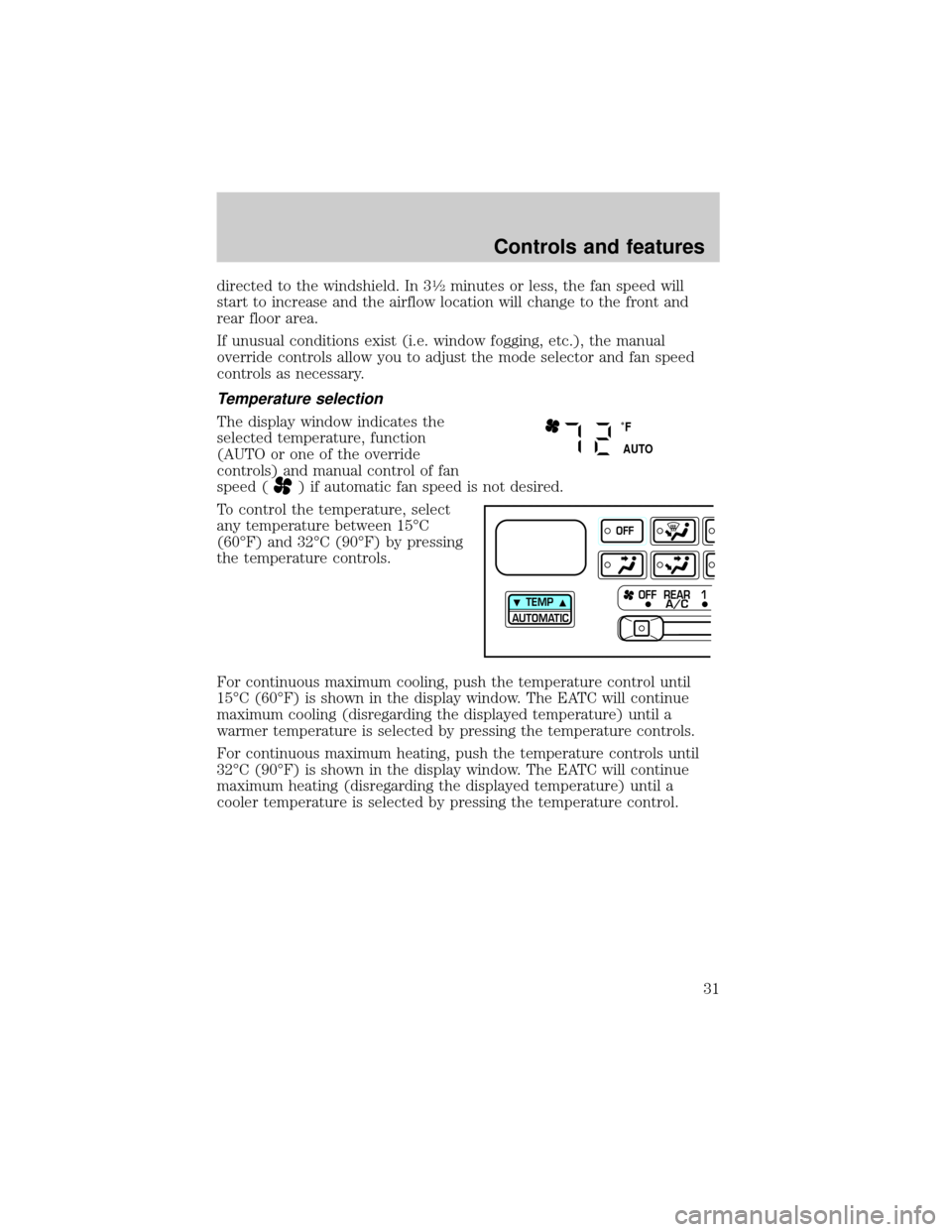
directed to the windshield. In 31¤2minutes or less, the fan speed will
start to increase and the airflow location will change to the front and
rear floor area.
If unusual conditions exist (i.e. window fogging, etc.), the manual
override controls allow you to adjust the mode selector and fan speed
controls as necessary.
Temperature selection
The display window indicates the
selected temperature, function
(AUTO or one of the override
controls) and manual control of fan
speed (
) if automatic fan speed is not desired.
To control the temperature, select
any temperature between 15ÉC
(60ÉF) and 32ÉC (90ÉF) by pressing
the temperature controls.
For continuous maximum cooling, push the temperature control until
15ÉC (60ÉF) is shown in the display window. The EATC will continue
maximum cooling (disregarding the displayed temperature) until a
warmer temperature is selected by pressing the temperature controls.
For continuous maximum heating, push the temperature controls until
32ÉC (90ÉF) is shown in the display window. The EATC will continue
maximum heating (disregarding the displayed temperature) until a
cooler temperature is selected by pressing the temperature control.
˚F
AUTO
TEMP
AUTOMATICOFF REAR 1
OFF
A/C
Controls and features
31
Page 33 of 256
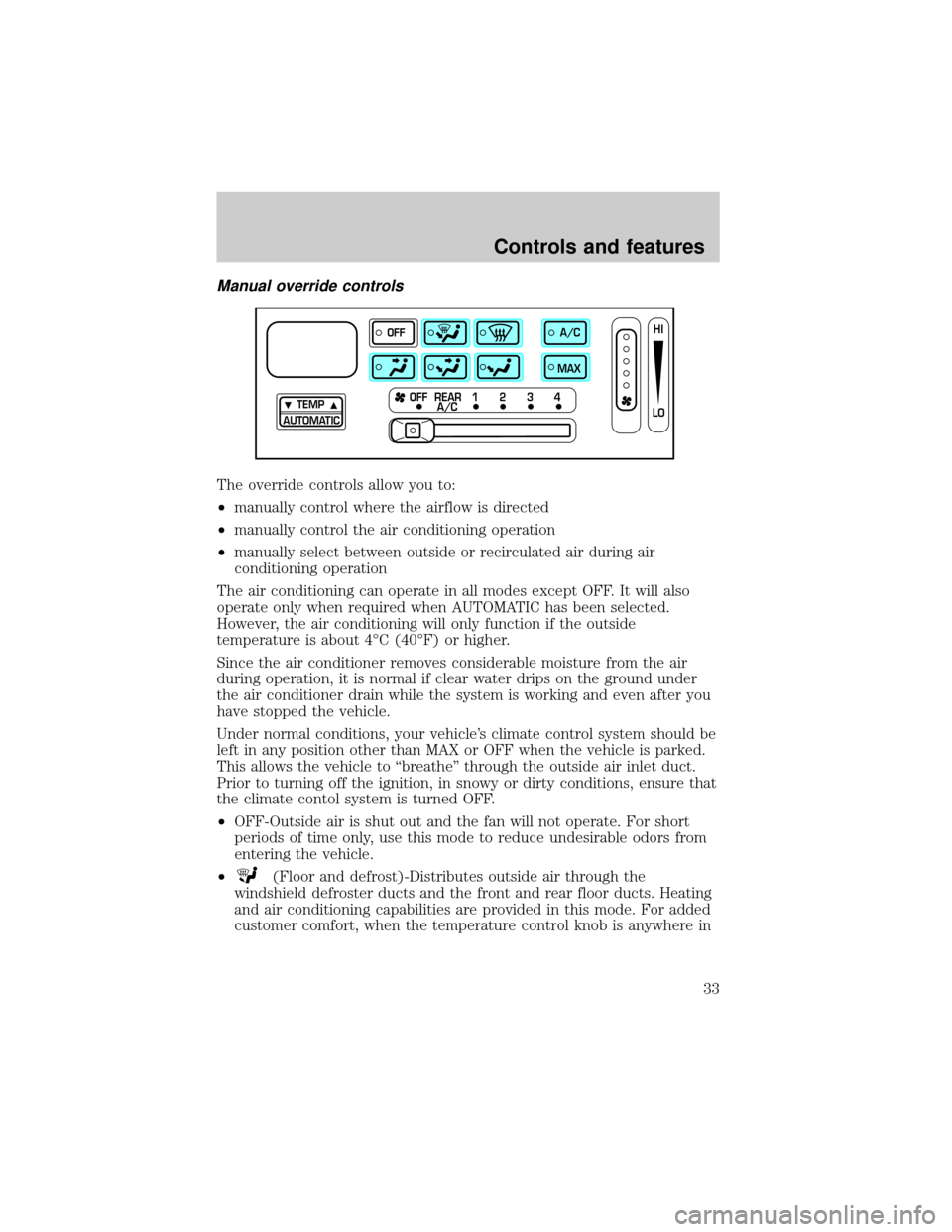
Manual override controls
The override controls allow you to:
²manually control where the airflow is directed
²manually control the air conditioning operation
²manually select between outside or recirculated air during air
conditioning operation
The air conditioning can operate in all modes except OFF. It will also
operate only when required when AUTOMATIC has been selected.
However, the air conditioning will only function if the outside
temperature is about 4ÉC (40ÉF) or higher.
Since the air conditioner removes considerable moisture from the air
during operation, it is normal if clear water drips on the ground under
the air conditioner drain while the system is working and even after you
have stopped the vehicle.
Under normal conditions, your vehicle's climate control system should be
left in any position other than MAX or OFF when the vehicle is parked.
This allows the vehicle to ªbreatheº through the outside air inlet duct.
Prior to turning off the ignition, in snowy or dirty conditions, ensure that
the climate contol system is turned OFF.
²OFF-Outside air is shut out and the fan will not operate. For short
periods of time only, use this mode to reduce undesirable odors from
entering the vehicle.
²
(Floor and defrost)-Distributes outside air through the
windshield defroster ducts and the front and rear floor ducts. Heating
and air conditioning capabilities are provided in this mode. For added
customer comfort, when the temperature control knob is anywhere in
TEMP
AUTOMATICOFF REAR 1 2 3 4
OFFA/C
A/CMAXHI
LO
Controls and features
33
Page 34 of 256
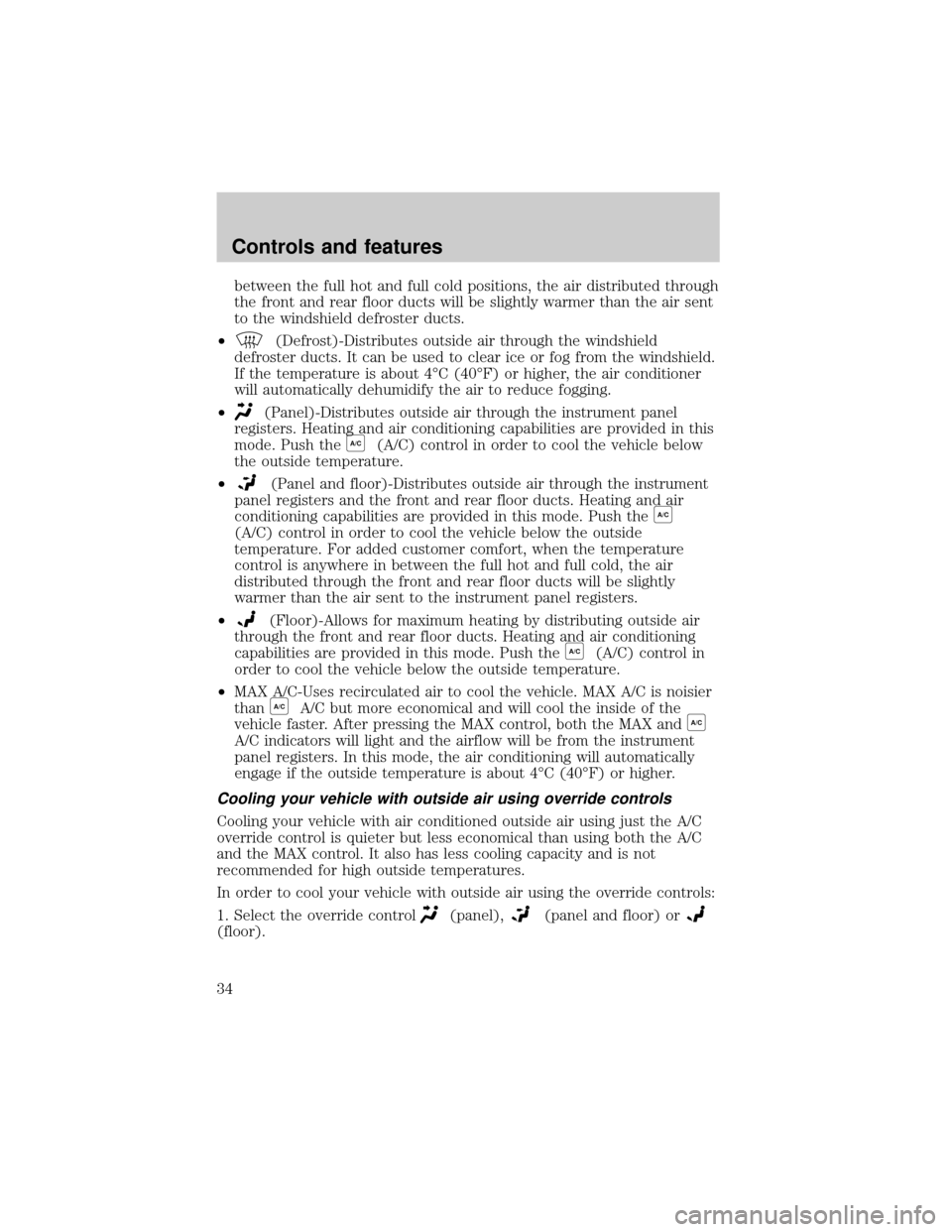
between the full hot and full cold positions, the air distributed through
the front and rear floor ducts will be slightly warmer than the air sent
to the windshield defroster ducts.
²
(Defrost)-Distributes outside air through the windshield
defroster ducts. It can be used to clear ice or fog from the windshield.
If the temperature is about 4ÉC (40ÉF) or higher, the air conditioner
will automatically dehumidify the air to reduce fogging.
²
(Panel)-Distributes outside air through the instrument panel
registers. Heating and air conditioning capabilities are provided in this
mode. Push the
A/C(A/C) control in order to cool the vehicle below
the outside temperature.
²
(Panel and floor)-Distributes outside air through the instrument
panel registers and the front and rear floor ducts. Heating and air
conditioning capabilities are provided in this mode. Push the
A/C
(A/C) control in order to cool the vehicle below the outside
temperature. For added customer comfort, when the temperature
control is anywhere in between the full hot and full cold, the air
distributed through the front and rear floor ducts will be slightly
warmer than the air sent to the instrument panel registers.
²
(Floor)-Allows for maximum heating by distributing outside air
through the front and rear floor ducts. Heating and air conditioning
capabilities are provided in this mode. Push the
A/C(A/C) control in
order to cool the vehicle below the outside temperature.
²MAX A/C-Uses recirculated air to cool the vehicle. MAX A/C is noisier
than
A/CA/C but more economical and will cool the inside of the
vehicle faster. After pressing the MAX control, both the MAX andA/C
A/C indicators will light and the airflow will be from the instrument
panel registers. In this mode, the air conditioning will automatically
engage if the outside temperature is about 4ÉC (40ÉF) or higher.
Cooling your vehicle with outside air using override controls
Cooling your vehicle with air conditioned outside air using just the A/C
override control is quieter but less economical than using both the A/C
and the MAX control. It also has less cooling capacity and is not
recommended for high outside temperatures.
In order to cool your vehicle with outside air using the override controls:
1. Select the override control
(panel),(panel and floor) or
(floor).
Controls and features
34
Page 35 of 256
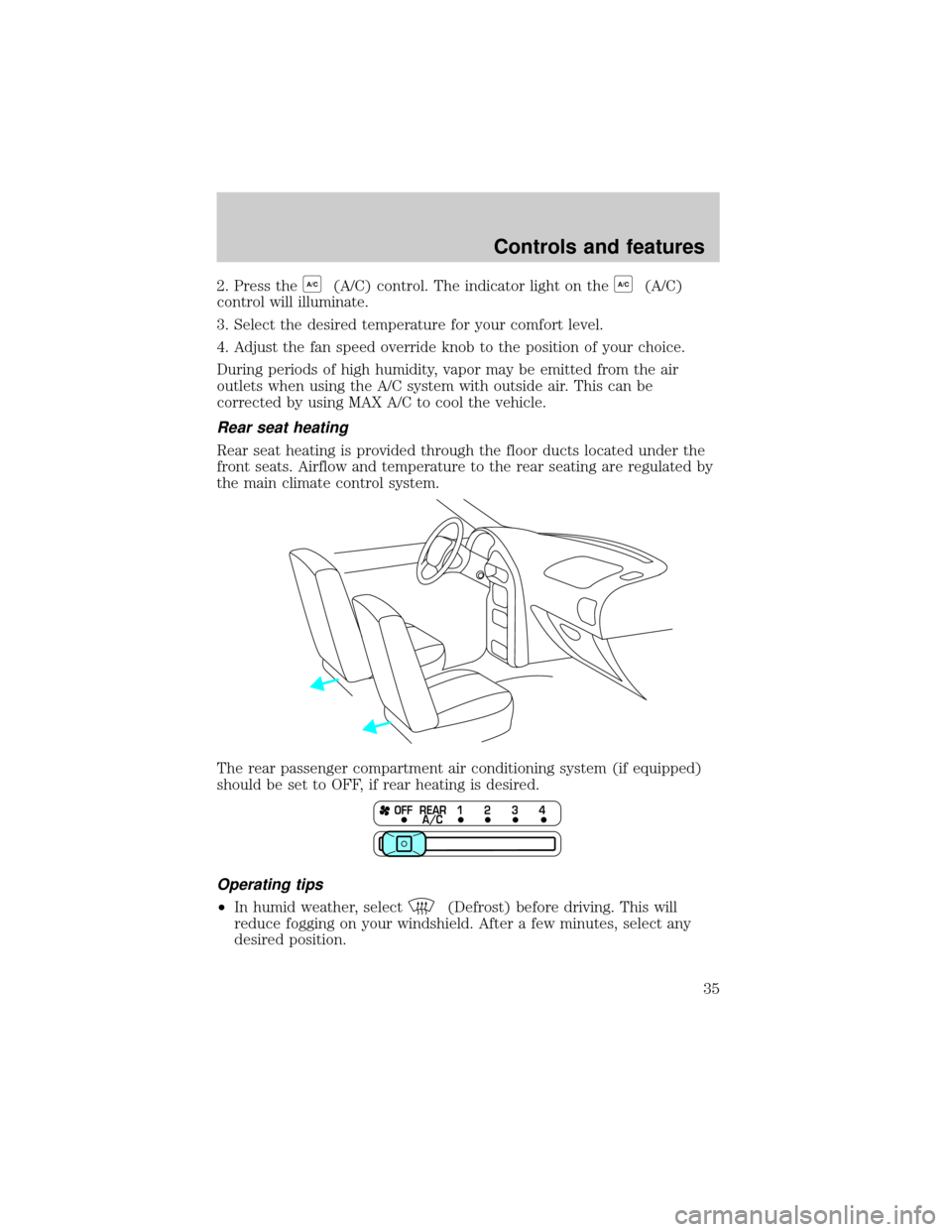
2. Press theA/C(A/C) control. The indicator light on theA/C(A/C)
control will illuminate.
3. Select the desired temperature for your comfort level.
4. Adjust the fan speed override knob to the position of your choice.
During periods of high humidity, vapor may be emitted from the air
outlets when using the A/C system with outside air. This can be
corrected by using MAX A/C to cool the vehicle.
Rear seat heating
Rear seat heating is provided through the floor ducts located under the
front seats. Airflow and temperature to the rear seating are regulated by
the main climate control system.
The rear passenger compartment air conditioning system (if equipped)
should be set to OFF, if rear heating is desired.
Operating tips
²In humid weather, select(Defrost) before driving. This will
reduce fogging on your windshield. After a few minutes, select any
desired position.
OFF REAR 1 2 3 4
A/C
Controls and features
35